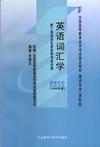英语词汇学
出版时间:1999-1 出版社:外语教学与研究出版社 作者:张维友 编 页数:275
Tag标签:无
前言
当您开始阅读本书时,人类已经迈入了21世纪。 这是一个变幻难测的世纪,这是一个催人奋进的时代,科学技术飞速发展,知识更替日新月异。希望、困惑、机遇、挑战,随时随地都有可能出现在每一个社会成员的生活之中。抓住机遇,寻求发展,迎接挑战,适应变化的制胜法宝就是学习——依靠自己学习,终生学习。 作为我国高等教育组成部分的自学考试,其职责就是在高等教育这个水平上倡导自学、鼓励自学、帮助自学、推动自学,为每一个自学者铺就成才之路,组织编写供读者学习的教材就是履行这个职责的重要环节。毫无疑问,这种教材应当适合自学,应当有利于学习者掌握、了解新知识、新信息,有利于学习者增强创新意识、培养实践能力、形成自学能力,也有利于学习者学以致用、解决实际工作中所遇到的问题。具有如此特点的书,我们虽然沿用了“教材”这个概念,但它与那种仅供教师讲、学生听,教师不讲、学生不懂,以“教”为中心的教科书相比,已经在内容安排、形式体例、行文风格等方面都大不相同了。希望读者对此有所了解,以便从一开始就树立起依靠自己学习的坚定信念,不断探索适合自己的学习方法,充分利用已有的知识基础和实际工作经验,最大限度地发挥自己的潜能达到学习的目标。 欢迎读者提出意见和建议。 祝每一位读者自学成功。
内容概要
当您开始阅读《英语词汇学》时,人类已经迈入了21世纪。这是一个变幻难测的世纪,这是一个催人奋进的时代,科学技术飞速发展,知识更替日新月异。希望、困惑、机遇、挑战,随时随地都有可能出现在每一个社会成员的生活之中。抓住机遇,寻求发展,迎接挑战,适应变化的制胜法宝就是学习——依靠自己学习,终生学习。
书籍目录
IntroductionChapter 1 Basic Concepts of W0rds and Vocabulary1.1 What Is a Word1.2 Sound and Meaning1.3 Sound and Form1.4 Vocabulary1.5 Classification of Words1.5.1 Basic Word Stock and Nonbasic Vocabulary1.5.2 Content Words and Functional Words1.5.3 Native Words and Borrowed WordsQuestions and TasksChapter 2 The Development of the English Vocabulary2.1 The Indo-European Language Family2.2 A Historical Overview of the English Vocabulary2.2.1 Old English(450-1150)2.2.2 Middle English(1150-1500)2.2.3 Modern English(1500一up to now)2.3 Growth of Present-day English Vocabulary2.4 Modes of Vocabulary DevelopmentQuestions and TasksChapter 3 Word Formation3.1 Morphemes3.2 Allomorphs3.3 Types of Morphemes3.3.1 Free Morphemes3.3.2 Bound Morphemes3.4 Root and StemQuestions and TasksChapter 4 WOrd Formation II4.1 Affixation4.1.1 Prefixation4.1.2 Surfixation4.2 Compounding4.2.1 Characteristics of Compounds4.2.2 Formation of Compounds4.3 Conversion4.4 Blending4.5 Clipping4.6 Acronymy4.6.1 Initialisms4.6.2 Acronyms4.7 Back-formation4.8 Words from Proper NamesQuestions and TasksChapter 5 Word Meaning5.1 The Meanings of‘Meaning5.1.1 Reference5.1.2 Concept5.1.3 Sense:5.2 Motivation5.2.1 Onomatopoeic Motivation5.2.2 Morphological Motivation5.2.3 Semantic Motivation5.2.4 Etymological Motivation5.3 Types of Meaning5.3.1 Grammatical Meaning and Lexical Meaning5.3.2 Conceptual Meaning and Associative MeaningQuestions and TasksChapter 6 Sense Relations and Semantic Field6.1 Polysemy6.1.1 Two Approaches to Polysemy6.1.2 Two Processes of Development6.2 Homonymy6.2.1 Types of Homonyms6.2.2 Origins of Homonyms6.2.3 Differentiation of Homonyms from Polysemant6.2.4 Rhetoric Features of Homonyms6.3 Synonymy6.3.1 Definition of Synonyms6.3.2 Types of Synonyms6.3.3 Sources of Synonyms6.3.4 Discrimination of Synonyms6.4 Antonymy6.4.1 Types of Antonyms6.4.2 Some of the Characteristics of Antonyms6.4.3 The Use of Antonyms6.5 Hyponymy6.6 Semantic FieldQuestions and TasksChapter 7 Changes in Word Meaning7.1 Types of Changes7.1.1 Extension7.1.2 Narrowing7.1.3 Elevation7.1.4 Degradation7.2 Causes of Changes7.2.1 Extra-linguistic Factors7.2.2 Linguistic FactorsQuestions and TasksChapter 8 Meaning and Context8.1 Types of Context8.1.1 Extra-linguistic Context8.1.2 Linguistic Context8.2 The Role of Context8.2.1 Elimination of Ambiguity8.2.2 Indication of Referents8.2.3 Provision of Clues for Inferring Word-meaningQuestions and TasksChapter 9 English Idioms9.1 Characteristics of Idioms9.1.1 Semantic Unity9.1.2 Structural Stability9.2 Classification of Idioms9.2.1 Idioms Nominal in Nature9.2.2 Idioms Adiectival in Nature9.2.3 Idioms Verbal in Nature9.2.4 Idioms Adverbial in Nature9.2.5 Sentence Idioms9.3 Use of Idioms9.3.1 Stylistic Features9.3.2 Rhetorical Features9.3.3 Variations of IdiomsQuestions and TasksChapter 10 English Dictionaries10.1 Types of Dictionaries10.1.1 Monolingual and Bilingual Dictionaries10.1.2 Linguistic and Encyclopedic Dictionaries10.1.3 Unabridged,Desk and Pocket Dictionaries10.1.4 Specialized Dictionaries10.2 Use of Dictionaries10.2.1 Choice of Dictionaries10.2.2 Content of the Dictionary10.2.3 Use of the Dictionary10.3 Three Good General Dictionaries10.3.1 Longrnan Dictionary of ContemporaryEnglish(LDCE)New Edition(1987)10.3.2 Collins COBU儿D English Language Dictionary(CCELD)(1987)10.3.3 A Chinese-English Dictionary (Revised Edition)(CED)(1995)Questions and TasksSuggested AnswersReference Books英语词汇学术语英汉对照表后记英语词汇学自学考试大纲
章节摘录
Etymology is traditionally used for the study of the origins and history of the form and meaningx。Of words.Modern English is de. ried from the languages of early Germanic tribes with a fairlv small vocabulary· We shall study how this small vocabulary has grown in. to a huge modern,Engl!sh vocabulary and explain the changes that have taken place in the forms and meanings of words. semantics lS the study of meanings of different linguistic levels: lexis,yntax’utterance,discourse,etc.But lexieology will focus on the lexical level.The types of meaning and sense relations such as polysemy,homonymy,synonymy,antonymy,hyponymy and semantic field all belong to the scope of semantic study and consti. tute an important part of lexicology. Stylistics is the study of style.It is concerned with the user,s choices oi linguistic elements in a particular context for speciaI ef. fects. Among the areas of study:lexis, phonology, syntax, graphology’we shall concentrate on lexis,exploring the stylistic values of words. Lexicography shares with lexicology the same problems:the from,meanm,origins and usages of words, but they have a pragmatic difference.A lexicographer’s task is to recird the lan- guage as it is used SO as to present the genuine picture of Words t0the reader,providing authoritative reference, whereas the studentof lexicology is to acquire the knowledge and information of lexis S0as to increase their lexical awareness and capacity of language use.
图书封面
图书标签Tags
无
评论、评分、阅读与下载
用户评论 (总计0条)
推荐图书
- 英语课文英汉对照译注(初3)
- 英语口语
- 涉外公务英语口语
- 英语口语教学
- Flash 5 职业技能培训教程
- 英语口语演练 高中卷
- 英语快速突破(第二辑)
- 英语快速突破(第一辑)
- 英语快速阅读能力自测丛书
- 英语扩充词汇阶梯阅读精通2000词汇
- 英语魔法书
- 英语魔法书
- 英语魔法书:高3 (平装)
- 北京市商业服务业英语培训教程:中级篇(磁带1盘)
- 英语巧记速记歌诀(初中三年级)
- 阅读套餐.初中卷
- 阅读套餐.大学卷
- 阅读套餐.高中卷
- 英语轻松听力丛书(初3)(附磁带2盘) (平装)
- 英语轻松听力丛书(初1)(附磁带) (平装)
- 英语升级阅读
- 英语实用写作能力提高-高中生写
- 英语说文解词
- 奥林匹克风
- 英语听力技巧(高中版)磁带5盘
相关图书
- 英语词句疑难解析
- 英语导航:高三年级(上册)
- 高职高专英语辅导4
- 初中卷.英语高分指导(写作.听力理解)
- 英语高分指导(高中卷)
- 初中卷.英语高分指导(阅读理解.口试)
- 初中英语听力关键
- 初中英语语法关键
- 初中英语阅读理解关键
- 高中英语写作技巧关键
- 英语国家概况:同步练习册(全国高等教育自学考试)
- 英语教程(1)教师用书(基础阶段)高职高专
- 英语教程
- 英语教程
- 英语教程
- 英语教程(3)教师用书(基础阶级)高职高专
- 英语教程
- 英语教程
- 英语教程 第四册
- 英语教程
- 英语教程第五册
- 英语教程第六册(专业部分)
- 英语教程(专业部分)
- 英语考试解题题典(本科学生6级6级后(硕士)考试专用)
- 英语考试应知应会词汇
